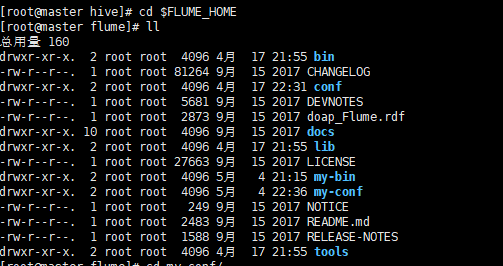本文主要是介绍Flume_Flume常用配置5_header + filter taildir.source_memory.channel_hdfs.sink,希望对大家解决编程问题提供一定的参考价值,需要的开发者们随着小编来一起学习吧!
以下配置基于版本 apache-flume-1.8.0-bin
我们假定已经对Flume有一定了解,并且对Flume 的各个组件有一定了解。
我们演示一个基本的source 为 taildir源
channel 为 memory
sink 为 hdfs 类型
的配置示例:
上一个配置中,我们对spooldir 源进行了简单的讲解,也提出了spooldir 中存在的问题,这一章我们对 1.8新推出的
taildir 进行下讲解,taildir 可以完美解决 spooldir 中存在的问题。
我们对 taildir 的原理进行下简单的介绍,
taildir 对一个目录进行监测,目录不支持 正则,等表达式,
会生成一个json文件,其中记录了每个文件的消费偏移量。
1. 宕机后,会从偏移量继续消费 ,所以一般不存在数据重复发送的问题。
但是该功能为 1.8 的实验性功能,目前只支持linux 环境,下面是示例配置
我们在解压好的目录下创建 2个子目录 my-conf, my-bin
my-conf 存放了 对 agent (source, sink, channel) 的配置
my-bin 存放了 agent 的启动脚本
在上一篇的基础上,我们增加了 过滤器 与 文件压缩 的配置
这里我们要说一说文件压缩,
如果我们配置了文件压缩,在sink 中 就不需要配置后缀了,因为文件压缩默认会有一个后缀,所以我们不需要额外的后缀
my-conf
my-bin
配置文件
my-conf/flume-taildir-memory-hdfs_withhead-codec.properties
# example.conf: A single-node Flume configuration# Name the components on this agent
hdfs_agent.sources = r1
hdfs_agent.sinks = k1
hdfs_agent.channels = c1# Describe/configure the source
hdfs_agent.sources.r1.type = TAILDIR
hdfs_agent.sources.r1.filegroups = f1
hdfs_agent.sources.r1.filegroups.f1 = /tmp/logs/tailDir/.*\.log
hdfs_agent.sources.r1.positionFile = /tmp/logs/tailDir/.flume/taildir_position.jsonhdfs_agent.sources.r1.interceptors = i1 i2 i3#拦截器配置
hdfs_agent.sources.r1.interceptors.i1.type = timestamp
hdfs_agent.sources.r1.interceptors.i1.preserveExisting = truehdfs_agent.sources.r1.interceptors.i2.type = host
hdfs_agent.sources.r1.interceptors.i2.preserveExisting = truehdfs_agent.sources.r1.interceptors.i3.type = static
hdfs_agent.sources.r1.interceptors.i3.key = country
hdfs_agent.sources.r1.interceptors.i3.value = China# Describe the sink
hdfs_agent.sinks.k1.type = hdfs
hdfs_agent.sinks.k1.hdfs.path = hdfs://192.168.75.128:9000/test/flume/hdfs_filegroups_source_header_codec/%{host}/%Y-%m-%d/
#文件转存属性
hdfs_agent.sinks.k1.hdfs.rollInterval = 3600
hdfs_agent.sinks.k1.hdfs.rollSize = 1048576
hdfs_agent.sinks.k1.hdfs.rollCount = 20
#文件的名字
hdfs_agent.sinks.k1.hdfs.filePrefix = %{host}_%{country}_log_%Y%m%d_%H
#当设置压缩属性的时候,不应该指定 文件后缀,否则会覆盖默认的压缩格式的后缀
#hdfs_agent.sinks.k1.hdfs.fileSuffix = .txt
#使得上面按天分目录的设置起作用
hdfs_agent.sinks.k1.hdfs.useLocalTimeStamp = true
#序列化方式
hdfs_agent.sinks.k1.hdfs.serializer = text_with_headers
#输出方式
hdfs_agent.sinks.k1.hdfs.codeC = bzip2
#输出方式
hdfs_agent.sinks.k1.hdfs.fileType = CompressedStream
#下面属性 只针对于 avro_event
#hdfs_agent.sinks.k1.hdfs.serializer.compressionCodec = bzip2# Use a channel which buffers events in memory
hdfs_agent.channels.c1.type = memory
hdfs_agent.channels.c1.capacity = 1000
hdfs_agent.channels.c1.transactionCapacity = 100# Bind the source and sink to the channel
hdfs_agent.sources.r1.channels = c1
hdfs_agent.sinks.k1.channel = c1
执行脚本
my-bin/start_taildir_memory_hdfs_withhead_codec.sh
#!/bin/bashROOT_PATH=$(dirname $(dirname $(readlink -f $0)))
cd $ROOT_PATHbin/flume-ng agent --conf ./conf/ -f my-conf/flume-taildir-memory-hdfs_withhead-codec.properties -Dflume.root.logger=INFO,console -n hdfs_agent这篇关于Flume_Flume常用配置5_header + filter taildir.source_memory.channel_hdfs.sink的文章就介绍到这儿,希望我们推荐的文章对编程师们有所帮助!








